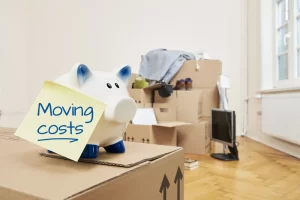Introduction:

Moving to a new state can be an exhilarating adventure, filled with both excitement and challenges. Whether you’re relocating for a job opportunity, a change in climate, or simply a fresh start, understanding how to move to another state is crucial. This guide will walk you through the essential steps to ensure your move is smooth and stress-free.
The excitement and challenges of moving to a new state:
Moving to different state lines can be a thrilling experience. Imagine exploring new landscapes, meeting new people, and diving into a fresh culture. However, long-distance moving also comes with its set of challenges. From understanding the cost of living calculator results to navigating the housing market, there’s a lot to consider.
Importance of planning and preparation for a smooth transition:
- Planning: Begin by creating a moving out of state checklist. This will serve as your roadmap, ensuring you don’t miss any crucial steps.
- Safety Considerations: Research the safety of your new neighborhood using tools like Google Maps Street views.
- Budgeting: Establish a moving budget early on. Consider costs like hiring professional movers, truck rental, and temporary housing.
- Choosing a New Home: Utilize resources like a realtor or online housing market platforms to find the perfect place.
- Job Market Research: If you’re moving for a job opportunity, ensure you’ve done thorough research on the job market in the new state.
1. Understand Why You’re Moving:

Before diving into the logistics of how to move to another state, it’s essential to grasp the reasons behind your decision. This understanding will guide your planning and preparation, ensuring a smooth transition.
Personal reasons:
Whether it’s a new job opportunity, being closer to family, or simply seeking a change of scenery, personal reasons often drive our decisions to relocate. Embracing these reasons can make the moving process more meaningful.
The allure of new opportunities and experiences:
Moving to a new state offers a fresh start. From exploring new landscapes to immersing yourself in a different culture, the allure of new experiences can be irresistible. Remember, every move is a chance to reinvent yourself and embrace new opportunities.
2. Research Your New State:
Knowledge is power, especially when undertaking something as significant as long-distance moving. Equip yourself with all the necessary information about your new state to make informed decisions.
Climate, cost of living, and more:
- Climate: Understand the weather patterns to prepare accordingly.
- Cost of Living: Use a cost-of-living calculator to gauge your expenses.
- Healthcare Facilities: Research the healthcare infrastructure, especially if you have specific medical needs.
- Housing Market: Explore the rental market and housing prices in your new state.
- Job Opportunities: If you’re relocating for a job, ensure you’ve done thorough research on the job market.
- Public Transportation: Familiarize yourself with the transport system, especially if you won’t have a personal vehicle immediately.
- Schools: If you have children, researching schools becomes paramount.
- State Laws: From filing a new driver’s license to understanding taxes, state laws can vary widely.
- Utilities: Plan utility transfers in advance to ensure a seamless move.
The importance of visiting the state before the move:
It’s always a good idea to visit your new state before the moving date. This visit allows you to get a feel for the place, explore neighborhoods, and even meet with potential long distance moving companies to get quotes. Use tools like Google Maps for street views and connect with local city halls or civic groups to gather more insights.
3. Financial Planning for the Move:
Embarking on a journey to a new state is not just about packing boxes and hiring movers. It’s also about ensuring that your finances are in order. Proper financial planning can make the difference between a smooth transition and a stressful one.
Setting a moving budget:

Estimate Costs: Begin by listing down all potential expenses. This includes quotes from moving companies like “Moving Companies Cincinnati ” or “moving services Cleveland “, truck rental fees, and packing supplies.
- Unexpected Expenses: Always factor in a buffer for unforeseen costs. This could be anything from a last-minute truck rental to additional packing supplies.
- Cost of Living: Use a cost of living calculator to understand how your expenses might change in the new state.
Potential employer support and stipends:
If you’re relocating for a job opportunity, it’s a good idea to check with your new employer about relocation stipends or support. Some companies offer:
- Relocation Stipends: A fixed amount to cover moving expenses.
- Full-Service Movers: They might have tie-ups with long-distance moving companies to facilitate the move.
- Temporary Housing: Some employers provide temporary accommodations until you find a permanent home.
Saving strategies:

Every penny counts when you’re making a big move. Here are some strategies to boost your moving budget:
- Cancel Non-Essential Subscriptions: This could be anything from magazines to online streaming services.
- Selling Unused Belongings: A move is a great time to declutter. Sell items you no longer need and add the proceeds to your moving budget.
- Part-Time Jobs: If your move date is a few months away, consider taking up a part-time job to save some extra cash.
4. Organize Your Move:
Organization is the key to a successful move. It ensures that you stay on track and don’t overlook any crucial tasks.
Creating a moving binder/checklist:
A moving binder or a moving out of state checklist is your roadmap for the move. It should include:
- Important Documents: This includes paperwork related to your move, utility transfers, and any mail and records that need updating.
- To-Do Lists: From hiring professional movers to updating your credit card company, list down all tasks with their deadlines.
- Inventory: Keep a list of all items you’re moving, especially valuable ones. This will be handy for insurance purposes and to ensure nothing gets lost in the move.
Importance of staying organized to reduce stress:
An organized move is not just about ticking off tasks on a checklist. It’s about ensuring peace of mind. Knowing that everything is in order allows you to focus on the excitement of starting afresh in a new state, rather than getting bogged down by the nitty-gritty of moving day.
5. Find a Suitable Place to Live:
Finding the perfect place to call home in your new state is both exciting and challenging. It’s not just about the house or apartment, but also the community, amenities, and the vibe of the neighborhood.
Online research and seeking help from realtors:
- Google Maps and Street Views: Before you even visit, take a virtual tour of potential neighborhoods. This gives you a feel for the area and its surroundings.
- Realtor Assistance: Engaging with a realtor can simplify your search. They have in-depth knowledge of the housing market and can guide you based on your preferences and budget.
- Online Platforms: Websites dedicated to property listings can be a goldmine of information. They often have pictures, reviews, and sometimes even virtual tours.
Considering the housing and rental market of the new state:
- Housing Market Research: Understand the buying prices in your new state. This will help you decide whether to buy immediately or rent for a while.
- Rental Market Insights: If you’re not ready to buy, familiarize yourself with the rental market. Look at average rents, lease terms, and any other requirements.
- Local City Halls and Civic Groups: Engage with local communities to get insights about the best places to live, schools, public transportation, and other amenities.
6. Hiring the Right Moving Company:
The right moving company can make your transition smooth and hassle-free. But with so many options out there, how do you choose?
The benefits of reputable DIY-moving services like Modern Movers:
- Cost-Effective: DIY-moving services like Modern Movers often offer competitive rates compared to full-service movers.
- Flexibility: You pack at your own pace, and they handle the transportation. It’s a win-win!
- Safety: Reputable companies ensure that your belongings are transported safely, reducing the risk of damage.
Evaluating moving companies based on experience, customer reviews, and locations:
- Experience Counts: Companies with years of experience in long-distance moving often have streamlined processes in place.
- Customer Reviews: Always check reviews and ratings on the business bureau. Past customers’ experiences can give you a good idea of what to expect.
- Locations: Ensure the company operates in both your current location and your destination. For instance, if you’re moving from Columbus, you might want to hire a moving company in Columbus, OH.
Call to Action: Embarking on an out-of-state move? Dive into our comprehensive Moving checklist for a step-by-step guide to ensure a seamless transition. Remember, with the right preparation and the perfect new home waiting for you, this move could be the best decision you’ve ever made. Safe travels and happy settling!
7. Preparing for the Move:
The excitement of moving to a new state can be overwhelming, but preparation is the key to ensuring a smooth transition. Let’s delve into the essential steps you need to take before your moving date.
Packing strategies and deciding what to take or leave behind:
- Inventory: Start by listing all your belongings. This will help you decide what’s essential and what can be sold or donated.
- Packing Supplies: Stock up on boxes, bubble wrap, and tape. Remember, the right packing supplies can prevent damage during long-distance moving.
- Decide What to Take: Consider the climate, space, and lifestyle in your new state. For instance, if you’re moving from a cold region to a warmer state, you might want to leave behind or sell some heavy winter gear.
- Selling Belongings: Organize a garage sale or list items online. This not only declutters but also adds to your moving budget.
Updating necessary paperwork: Change of address, DMV updates, insurance policies, etc.:
- Change of Address: Notify the post office of your new address. This ensures that your mail and records are forwarded to your new home.
- DMV Updates: It’s crucial to file a new driver’s license and update vehicle registration when crossing state lines.
- Insurance Policies: Update home, car, and health insurance policies to reflect your new address.
- Utilities and Subscriptions: Schedule utility transfers and update subscriptions like magazines or online services.
8. Making Social Connections in the New State:
Moving isn’t just about physical belongings; it’s also about establishing roots and building connections in your new community.
Joining local groups or clubs:
- Local City Halls and Civic Groups: These often have community events or groups that can help you integrate faster.
- Hobby Clubs: Whether it’s a book club, hiking group, or a cooking class, joining a club related to your interests can be a great way to meet people.
- Sports Teams: If you’re into sports, local teams or fitness groups can be a great way to socialize.
Leveraging social media for real-life connections:
- Community Groups: Platforms like Facebook have local community groups where residents share news, events, and recommendations.
- Meetup: Websites like Meetup.com can help you find local events or groups that align with your interests.
- Networking: LinkedIn or local job market research platforms can connect you with professionals in your field.
The importance of integrating into the new community for mental well-being:
Building social connections is not just about making friends; it’s also crucial for your mental well-being. Feeling integrated and connected can help combat feelings of isolation or homesickness that might arise after relocating.
9. Post-Move Tasks:
Congratulations on successfully moving to a new state! While the hard part might be over, there are still some tasks to tackle to ensure you settle in comfortably.
Unpacking and setting up your new home:
- Prioritize: Start with essentials like the kitchen and bathroom. Having this function will make the initial days more comfortable.
- Organize: As you unpack, organize your belongings in a way that suits your new home’s layout. This is also a good time to invest in any – – additional storage or furniture you might need.
- Decorate: Make your space feel like home. Hang up photos, set out familiar items, and decorate as you see fit.
Exploring the neighborhood and local amenities:
- Take a Walk: Familiarize yourself with the neighborhood. Locate essential places like grocery stores, pharmacies, and local city halls.
- Google Maps and Street Views: Use these tools to explore your surroundings virtually and find local amenities.
- Engage with Neighbors: Introduce yourself to your neighbors. They can provide valuable insights about the community and might even become good friends.
Building a new routine:
- Daily Tasks: Establish a daily routine. This includes meal times, work schedules (especially if you’re engaging in Remote Work), and relaxation.
- Social Connections: Join local groups or clubs to meet new people and build a social network.
- Stay Updated: Keep an eye on local news or community boards to stay informed about events or any changes in state laws that might affect you.
10. FAQ Section:
Navigating an out-of-state move can be daunting, but we’re here to help. Here are some frequently asked questions to guide you further.
How long should I plan for an out-of-state move?
A: Planning is crucial for a successful move. Ideally, start preparing at least two to three months before your moving date. This gives you ample time for tasks like hiring professional movers, organizing your belongings, and completing the moving out of state checklist.
What are the common challenges faced during such moves and how to overcome them?
A: Some challenges include adjusting to a new climate, understanding the cost of living, and building a new social circle. Overcome these by doing thorough state research, using tools like a cost of living calculator, and actively engaging in social connections in your new community.
Tips for moving with pets or children?
- Prepare Them: Talk to your children about the move. For pets, ensure they have a comfortable carrier.
- Safety First: On moving day, consider arranging for childcare or pet-friendly accommodations.
- Settling In: Once you’ve moved, help them adjust by setting up familiar spaces, like a child’s room or a pet’s corner, as soon as possible.
Call to Action: Ready to make your new state feel like home? Dive deeper with our Pro moving tips for a comprehensive guide on settling in and making the most of your new environment. Remember, every move is a new adventure, and with the right resources, you’re well on your way to starting a thrilling new chapter. Welcome to your new home!





